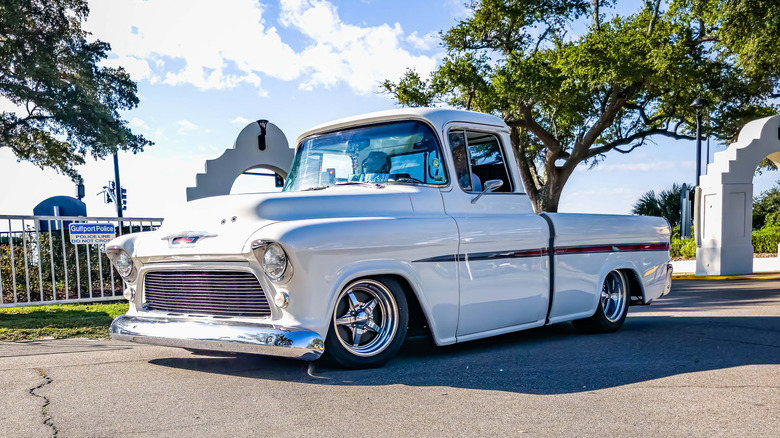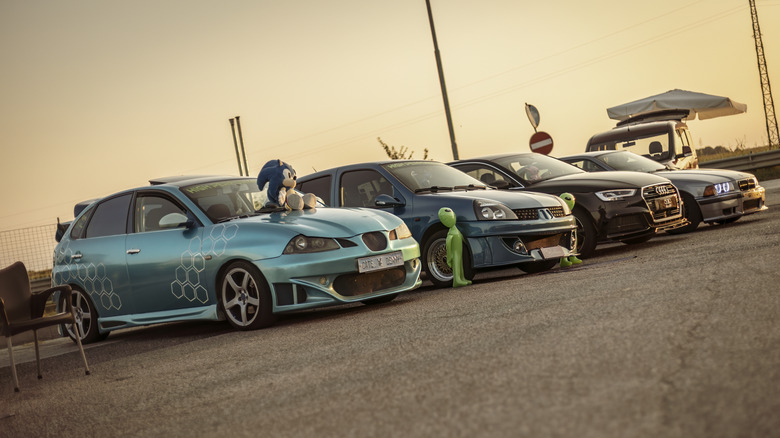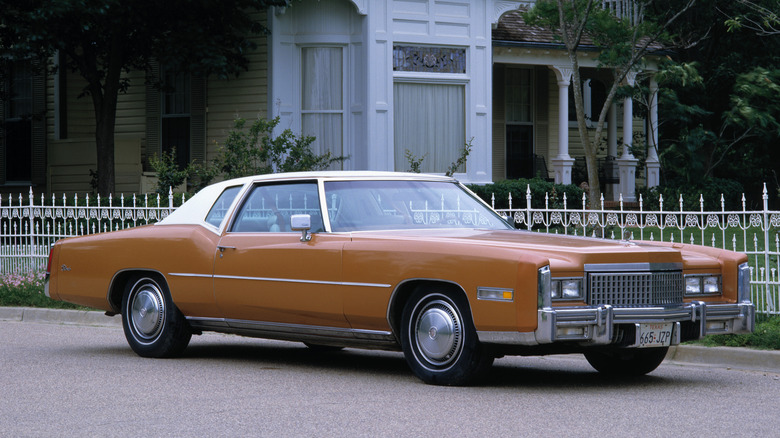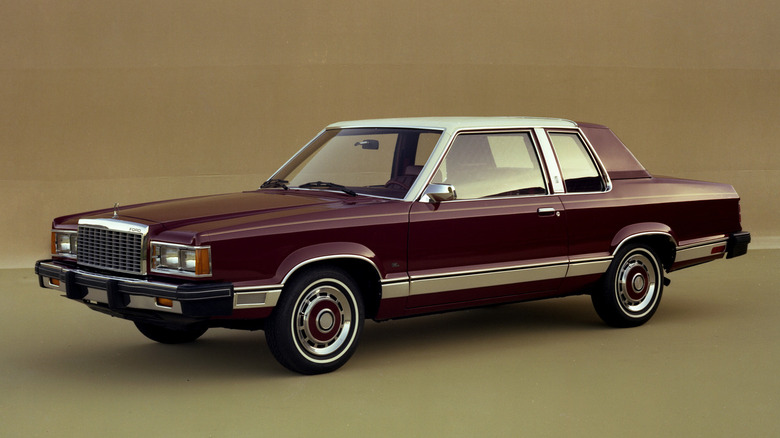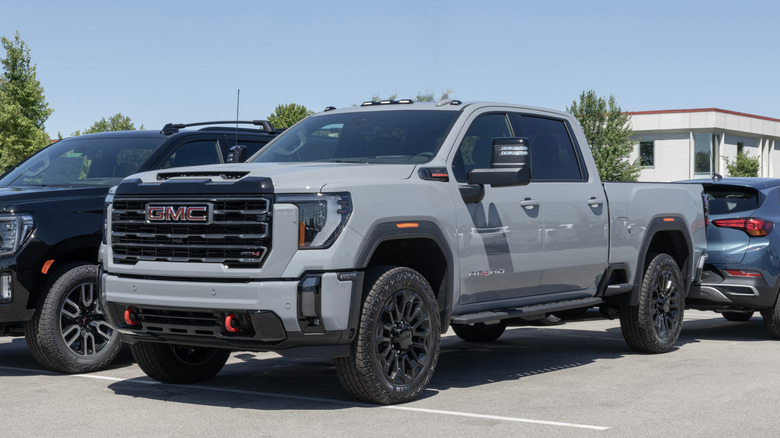5 Of The Worst Car Trends We've Ever Seen
Like it or not, automobiles have been a part of our daily lives for over a century now. We've witnessed some distinctive eras throughout those years, with iconic periods like the 1950s finned cars, 1960s muscle, 1970s Malaise Era, and so on. Breaking it down further, each of these eras contains a whole host of trends and fads, some of which are products of the cultural zeitgeist of the time, and some just leave you scratching your head in bewilderment. Certainly it leaves me bewildered, and I've owned, worked with, and studied many of these cars for over a decade now.
When it comes to making a list encompassing all of these trends, it's simply mind-boggling to even think about how many different terrible decisions automakers have perpetuated, sometimes for decades on-end. Generally speaking, many of these came about with the best of intentions, or because of situations outside of the manufacturers' control. For example, the infamous Malaise Era was kick-started by the 1973 Oil Crisis, and again worsened in 1979 from the Iranian Revolution oil embargo. Or, along similar lines, you have the Car Allowance Rebate System (better known as Cash for Clunkers), birthed from the 2007 financial crisis. Such significant events forever-altered the face of the automotive industry, and led to completely justifiable, if questionable, decisions on behalf of owners and the automakers themselves.
But what about the trends that are not only bizarre, but had (or have) no good justification? What about trends that wound up being detrimental to the driving experience, if not outright dangerous? Or just the ones that we look back on and wonder, "Why though?" Let's explore five of the absolute worst of these, how they came about, and why they're so awful for the auto industry.
The tuner era of the 2000s
This is a very broad category, but you know the type of car when you see it. These vehicles often feature entirely cosmetic enhancements with no actual performance to back it up, a trend which has a deceptively long lineage but really peaked in the early-2000s. This takes us back to when tuners soared in popularity and we got some truly iconic cars.
On the other end of that spectrum, though, was the growth of one of the most bizarre-looking automotive subcultures. Wild bodywork, cut-down springs, neon underglow, large spinning rims, exhaust cans, massive rear wings, fake carbon fiber, and tacky decals, all generally fitted to a cheap beater Japanese sedan. It wasn't pretty, it certainly wasn't functional, and it was everywhere in the racing scene at the time, popularized by games and movies alike. Granted, it was all some people could afford and had the skill to perform at the time. But looking back, wow, was it a situation, like looking at your old yearbook photos.
These days, the trend of form over function on such vehicles soldiers on, with highly-stanced cars owing their lineage to drifting and early tuner culture. And I will absolutely pay respect to the workmanship that goes into making these cars actually drive, even if one time a stanced BMW had a tire blowout on the highway right in front of me. This is more in regard to the days before we cleaned up their lines, when we bought these "mods." Back when we were kids and didn't know any better, and inadvertently built some of the most horrifying-looking creations. Thankfully, a lot of these modifications are reversible if people, for whatever reason, don't want their pristine classic Integra to sound like a weed eater.
High-intensity headlights
Headlights are quite possibly one of the most vital components on a vehicle not directly related to its operation. And over the years, many manufacturers iterated on the basic design, with innovations such as sealed beams, aerodynamic housings, and long-lasting bulbs remaining ubiquitous. Plus you have a lot of novel concepts like headlights that move with the steering wheel. But one of the most recent — and worst — trends for headlights is unquestionably their brightness. Let's put aside how the ever-increasing height of SUVs and crossovers makes headlights shine directly into lower vehicles' cabins, though that is a component of the problem. The actual measure of how much light they emit has also dramatically increased over the years, averaging double the brightness versus just a decade ago.
People often cite the use of HID headlights as improving safety, making your vehicle look more modern/upscale, or just giving you more confidence at night. But the fact is that the human eye evolved with an inherent night vision which simply does not comply with blinding lights pointed right into your rearview mirror. It's why people held lanterns beside them rather than in front of their heads back in the old days.
The consequences of everyone having brighter headlights means that you paradoxically cannot actually see as much, because your night vision is ruined by the oncoming traffic and lights in your mirrors. This necessitates equipping your vehicle with more powerful headlights to compensate, and the cycle continues. This trend proves even more dangerous with people who fit high-intensity beams to older vehicles not designed for them, and then don't calibrate the headlights to compensate.
The 1970s luxury barge
Picture an American car designed for the Oil Crisis. It's the mid-1970s, anti-smog is catching on, people have just recovered from the shock of waiting in massive lines for gas, and small Japanese imports shook the American auto industry to its core. These vehicles won over many first-time owners with promises of reliability, efficiency, and a low MSRP. American automakers directly competed with these sorts of vehicles with subcompacts like the Pinto, Vega, and Pacer. Sometimes these cars were even good. But prominently displayed next to them at dealerships sat their larger luxury siblings: cars like mid-1970s Cadillacs, for example, fitted with an absolutely mammoth 500 cubic-inch V8.
Rushing to comply with tightening restrictions, manufacturers chose to retain their lineup and fit these massive engines with primitive emissions controls while they transitioned to midsize options. This led to a brief period of giant land-yachts with engines choked to within an inch of their lives. Like that huge V8, which Cadillac must've put some sort of esoteric curse on because they somehow managed to drop its output to just 190 horsepower. From the largest V8 ever fitted to a regular production car, displacing more air than their interwar 7.4L V-16. That takes skill.
The main problem is that while this lowered the vehicle's emissions, it absolutely plummeted efficiency figures. And this goes for many of these larger vehicles, now equipped with significantly-underpowered engines. These thirsty engines now had to work twice as hard to move all that car, which led to numbers hitting single-digit MPG. These were absolutely the wrong car at the wrong time, and woe to the poor souls who had to keep them fueled as prices jumped by a factor of four in less than a decade.
Vinyl roofs (and the damage they caused)
The popularity of vinyl roofs really peaked during the 1960s and 1970s, often equipped on cars with "designer" trims like the Mustang II Ghia, or as options on many American sedans and coupes. It was a fairly cheap and easy way to make a regular passenger car look more luxurious and upscale, and provided a nice color contrast if you wanted a two-tone look. These options were everywhere and, for their day, looked quite nice. However, that's pretty much where the good times stopped, and today, vinyl roofs are routinely placed among one of the worst ideas in automotive design.
Much like how simulated wood-grain paneling significantly dates a car's exterior (though some cars look fantastic with the fake wood, I got to say), so too did the vinyl hardtop, and so are rarely seen beyond the 1980s. Unlike an actual convertible, these were essentially just big decals placed on top of metalwork: metalwork which rusts. Any quick Google search reveals a huge laundry-list of shops performing rust-repair under vinyl tops like this.
So what on Earth went wrong? Well, put simply, because these are glued on and not actual bodywork, vinyl tops can get scuffed and damaged. Cracks can readily form, especially in areas with high temperature differences, and often damage what's underneath. So you'd rip up the old, desiccated vinyl, revealing huge rust holes from where water damage propagated beneath the cracks, often for many years.
True, this trend has its fans, and a well-maintained vinyl hardtop can look good. You can also go DIY if you have good metal underneath as well, but generally, this trim caused a litany of problems. At least it's good for keeping vintage auto body repair shops in business, so that's something.
Pickup trucks with unsafe design proportions
There's a huge rabbit hole behind why pickups grew so substantially since the 2000s. Modern pickup trucks and their derivatives pride themselves on being the absolute largest usable passenger vehicles, with towering proportions dwarfing many other cars and pedestrians. The growth of the pickup is a well-documented phenomenon, caused by factors such as the 1962 Chicken Tax and today's EPA regulations. Basically, EPA standards state that the bigger the vehicle's footprint, the less fuel-efficient it needs to be to pass testing. This means it's easier for automakers to develop such vehicles to meet these regulations. In addition, more people desire the convenience, cargo space, and utility of crossovers and pickups, so it's a win-win all around. Although unibody pickups like the new Ford Ranger prove compact trucks' viability, their larger counterparts continue dominating sales.
Now, there's nothing inherently wrong with fullsize pickups. However, their huge, prominent front ends are legitimately dangerous to pedestrians, thus easily placing this trend at the top.
Over the years, various organizations and crash safety results published findings that hood height increased pedestrian fatality rates by up to 45%. And blind spots below the hood line of even mildly lifted trucks are so poor that even some stock ride-height pickups have hoods at eye-level with adults. While not the sole contributor to the 80% pedestrian accident death increase since 2009, it certainly isn't helping. Though thankfully, modern proposals aim to reign in this horrifying safety risk. Still, the fact that this trend has gone on for so long when we banned pop-up headlights for their risk to pedestrian safety is, frankly, hypocritical and abhorrent.
